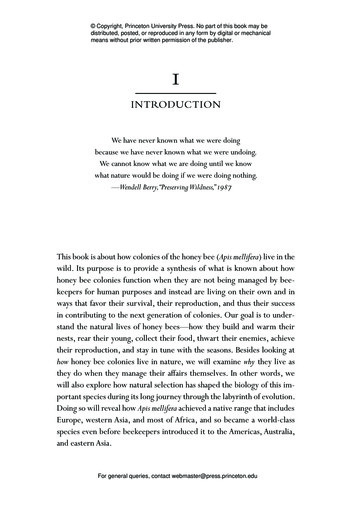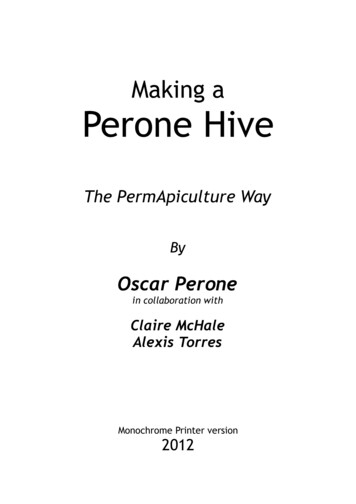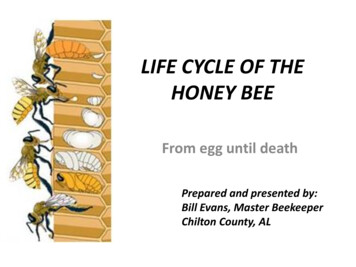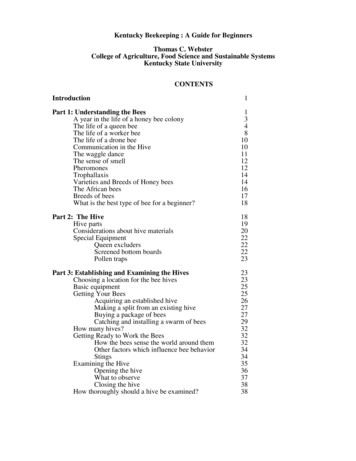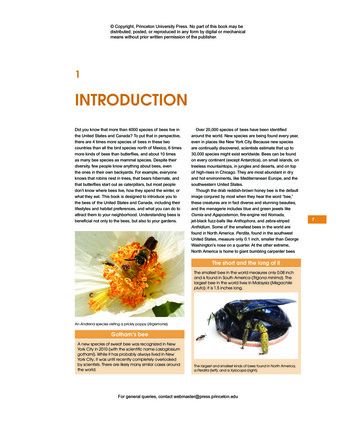
Transcription
Copyright, Princeton University Press. No part of this book may bedistributed, posted, or reproduced in any form by digital or mechanicalmeans without prior written permission of the publisher.1INTRODUCTIONDid you know that more than 4000 species of bees live inthe United States and Canada? To put that in perspective,there are 4 times more species of bees in these twocountries than all the bird species north of Mexico, 6 timesmore kinds of bees than butterflies, and about 10 timesas many bee species as mammal species. Despite theirdiversity, few people know anything about bees, eventhe ones in their own backyards. For example, everyoneknows that robins nest in trees, that bears hibernate, andthat butterflies start out as caterpillars, but most peopledon’t know where bees live, how they spend the winter, orwhat they eat. This book is designed to introduce you tothe bees of the United States and Canada, including theirlifestyles and habitat preferences, and what you can do toattract them to your neighborhood. Understanding bees isbeneficial not only to the bees, but also to your gardens.Over 20,000 species of bees have been identifiedaround the world. New species are being found every year,even in places like New York City. Because new speciesare continually discovered, scientists estimate that up to30,000 species might exist worldwide. Bees can be foundon every continent (except Antarctica), on small islands, ontreeless mountaintops, in jungles and deserts, and on topof high-rises in Chicago. They are most abundant in dryand hot environments, like Mediterranean Europe, and thesouthwestern United States.Though the drab reddish-brown honey bee is the defaultimage conjured by most when they hear the word “bee,”these creatures are in fact diverse and stunning beauties,and the menagerie includes blue and green jewels likeOsmia and Agapostemon, fire-engine red Nomada,jet-black fuzz-balls like Anthophora, and zebra-stripedAnthidium. Some of the smallest bees in the world arefound in North America. Perdita, found in the southwestUnited States, measure only 0.1 inch, smaller than GeorgeWashington’s nose on a quarter. At the other extreme,North America is home to giant bumbling carpenter bees7The short and the long of itThe smallest bee in the world measures only 0.08 inchand is found in South America (Trigona minima). Thelargest bee in the world lives in Malaysia (Megachilepluto); it is 1.5 inches long.An Andrena species visiting a prickly poppy (Argemone).Gotham’s beeA new species of sweat bee was recognized in NewYork City in 2010 (with the scientific name Lasioglossumgothami). While it has probably always lived in NewYork City, it was until recently completely overlookedby scientists. There are likely many similar cases aroundthe world.The largest and smallest kinds of bees found in North America,a Perdita (left), and a Xylocopa (right).For general queries, contact webmaster@press.princeton.edu01 Bees N America pp001-069.indd 728/07/2015 12:47
Copyright, Princeton University Press. No part of this book may bedistributed, posted, or reproduced in any form by digital or mechanicalmeans without prior written permission of the publisher.Introduction8(Xylocopa). At more than an inch long, they sound likeminiature helicopters as they hover near flowers.Bees are thought to increase seed set in 70% of allflowering plants, including many of the fruits and vegetableswe enjoy. The special relationship that exists betweenbees and the flowers they visit is not only economically(and gastronomically) important; it is also unique from abiological perspective. Although there are other organismsthat are capable of pollination (and are, in fact, good at it),bees are the only ones to actively gather pollen from theflowers they visit, creating an evolutionary dynamic seennowhere else in the animal kingdom. Despite the particulartalents and unquestionable importance of bees, scientistshave reason to believe that some bee species may beexperiencing widespread population declines. While thespecifics are still being assessed, some things are certain:bees are all around us, they enhance the quality of ourlives, and they benefit from our improved understanding ofthem and their needs.Our hope is that this book will turn amateur naturalists,gardeners, entomologists, and curious souls on to theamazing lives of the bees that not only reside in untamedwild areas, but also flourish in our very neighborhoods. Withunderstanding comes appreciation; in addition to describingthe life stories associated with the many bee species of theUnited States and Canada, we provide examples of waysto encourage these wonderful pollinators on your own plotof land.A Megachile, resting on a cactus flower (Echinocereus).Is This a Bee?1.1 IS THIS A BEE?Even though bees are common in most neighborhoods,frequently seen on hikes, and ubiquitous residents ofcity parks, it is hard to tell whether an insect buzzingnearby is a bee or something else. It’s no wonder peopleget confused. Because bees sting, resembling one is asuccessful strategy for vulnerable insects, and many a bughas evolved the appearance of a buzzing bee; however, akeen eye and a little practice are all you need to see pastthe ruse.Bees and wasps are the most similar in appearance, andthey are the most easily confused. It is not uncommon tohear complaints about the “bee” that landed on somebody’shamburger at a recent family picnic. Stories of the peskynest dangling from a branch in the backyard abound.Hikers complain about the horrible buzzing creatures thatswarmed from a log they used as a backrest halfway up thetrail. And every summer, someone is attacked by “groundbees” while mowing the lawn. In all cases, the annoyinginsect was probably not a bee but a wasp. Wasps (includinghornets and yellow jackets) and bees are close relatives,sharing in common a grandmother 100 million “greats” ago.In some instances the two are so similar that even trainedscientists have difficulty distinguishing them. The bee calledNeolarra (see section 9.1), for example, was thought to be awasp by the first researchers to see it. It didn’t help that thebee was dead and stuck to a pin, because the most tellingFrom highest to lowest, a fly, a wasp, and a bee visiting a“watering hole.” On the fly, note the short antennae just visibleon the face. On the bee, note the yellow masses of pollen on thelegs, which the wasp is lacking. Photo by B. Seth Topham.For general queries, contact webmaster@press.princeton.edu01 Bees N America pp001-069.indd 828/07/2015 12:47
Copyright, Princeton University Press. No part of this book may bedistributed, posted, or reproduced in any form by digital or mechanicalmeans without prior written permission of the publisher.Is This a Bee?Meat-eating bees andpollen-eating waspsThere are exceptions to nearly every rule aboutthe differences between bees and wasps. In SouthAmerica, for example, a group of bees (Trigona)feeds its young with dead animal flesh, and in NorthAmerica a group of wasps (Pseudomasaris) feeds itsyoung with pollen.fliesbeeswaspsIntroductiondifferences between bees and wasps are their mannerismsand day-to-day behaviors.Most important among these behavioral differences isthat bees are pollen eaters. Wasps, in contrast, are meateaters. While both visit flowers for nectar (the “energydrink” of the insect world), bees also visit flowers in order tocollect pollen for their young. On the contrary, wasps pursueother insects and drag them back to the nest for theiroffspring to devour. This one dietary difference has resultedin very different bearings. To aid in the gathering of pollen,bees are usually hairy (pollen sticks to hair), and manyspecies look like cotton candy with wings. Rooting around inflowers is messy business, and a few minutes rummagingamong floral parts leaves a bee coated in hundreds of tinygrains of pollen. Using her many legs, the bee groomsherself, wiping all the pollen to the back of her body, whereshe stuffs it into the spaces between special stiff bristleson her legs or belly. These tufts or masses of special hairsare called scopa. Quite the opposite of the furry bee, waspslook like Olympic swimmers, devoid of all hair, skinnywaisted, and with long spindly legs.9This image shows some common flies (left), bees (middle), andwasps (right). You can see that the three groups commonlylook a lot alike and that it takes an experienced eye to see thedifferences. Notice that all the flies have triangular heads (whenviewed from above) with short little antennae and just one wingon each side of the body. Wasps and bees look even more similar;look for rough integument (skin) on wasps, with many tiny pits, aswell as antennae that commonly are very close together on theface, and spindly legs.A Melissodes bee foraging on a sunflower (Helianthus) with a largepollen load stuffed into the pollen-collecting hairs (scopa) on theback legs.For general queries, contact webmaster@press.princeton.edu01 Bees N America pp001-069.indd 928/07/2015 12:47
Copyright, Princeton University Press. No part of this book may bedistributed, posted, or reproduced in any form by digital or mechanicalmeans without prior written permission of the publisher.IntroductionIt’s so fluffy!Bees generally have lots of hair; wasps don’t. In fact,one of the few consistent differences between thetwo is that, somewhere on their little bodies, bees havebranched hairs similar to tiny feathers.10There are exceptionsto every rule, of course.Some bees have scanthair on their bodies andare wasp-thin. In thesecases, look for silveryor golden hairs on theface; wasps tend to haveglistening mugs, whilebee hairs don’t shimmerfrom any angle. Behavior,A wasp. Note theas mentioned above,silvery hairs on the face, andcan be telling, too. Beesthe long spiny legs. The spineshelp hold onto insect prey thespend more time onsame way cat claws do.flowers than wasps do;wasps in contrast aremore likely to raid your backyard barbeque in search ofanimal proteins accidentally left on a plate.Since bees and wasps are difficult to distinguish, manystung victims often blame the hapless bee for crimes notThe hive of a paper wasp at the height of activity. Most bees donot live in hives, and their homes can more accurately be callednests. Nests are typically in the ground, and each nest usuallyhouses one individual, instead of a whole colony.Is This a Bee?committed. The culprit in these cases is likely a paper wasp,a hornet, or a yellow jacket. All live socially in hives. Everthe opportunists, these wasps take advantage of the manyresources found in urban environments, often building theirhomes along fences, under eaves and decks, attached towindowsills, or in various holes or cavities. All three willcollect fibers from dead wood and plants and then usetheir saliva to make a papier-mâché house of sorts. Thesenests often bear a strong resemblance to the honey beehives depicted in Winnie the Pooh books, and it is thus notsurprising that many people think these wasps are bees.These kinds of wasps also enjoy taking a bite of your grilledchicken back to the nest to feed their offspring, or stoppingA paper wasp ripping apart a katydid to transport back to thenest (wasps are voracious carnivores). Note the long narrowwings, folded in half and draped like thin ribbons down each sideof the back.A yellow jacket’s nest is built from a paper-like substance and isfrequently mistaken for a beehive. While many people think thesewasps’ nests are beehives, bees do not make exposed paper-likehives. Photo by Lindsey E. Wilson.For general queries, contact webmaster@press.princeton.edu01 Bees N America pp001-069.indd 1028/07/2015 12:47
Copyright, Princeton University Press. No part of this book may bedistributed, posted, or reproduced in any form by digital or mechanicalmeans without prior written permission of the publisher.Is This a Bee?IntroductionBee vs. wasp (physical differences)BeeWaspusually thick-bodiedskinny body with narrowwaistno silver hair on faceoften with silver hair on faceoften very hairygenerally hairlesspollen-collecting hairno pollen-collecting hairson legs or belly of femalesstout legs with relativelyfew spineslong thin legs with spineson the lip of your glass of root beer for a sugary sip. Thegangly, thin-waisted, and hairless body gives them awayas wasps and not bees, however. In addition, the wings ofthese wasps in particular are folded in a distinctive way.Rather than lying flat across their back (thorax) so theyoverlap over the abdomen, their wings run as parallel darkstrips on either side of the thorax.Though not close relatives of bees the way thatwasps are, many flies mimic the bee look. For a fly, theadvantages to playing copycat are huge. Bees have spentmillennia evolving stings and every creature on landhas learned that they are not to be messed with. For afly, looking so painful can save them from becoming thelunch option of hungry birds, reptiles, and other potentialpredators. For a predator, of course, being able to tell thedifference between a bee and a fly increases the numberof options at the insect buffet. Over time, the discerningeye of the predator has therefore weeded out the not-sogood fly look-alikes, leaving behind flies that at first glanceseem identical to bees—down to “pretend” pollen-collectinghairs on the legs!Flies have several important characteristics that canhelp separate them from bees. First, flies have only two11Bee vs. fly (physical differences)BeeFlylong slender antennaeshort antennaefour wingstwo wingsdistinctly separatedthorax and abdomen“thick waist” where thoraxconnects to abdomenpollen-collecting hair onlegs or bellyno pollen-collecting hairseyes on sides of headeyes large, often forwardfacing, sometimes touchingon top of headFive insects. Only one is a bee, though the other four arecommonly mistaken for bees. From top to bottom: a mud dauberwasp, a paper wasp, a yellow jacket, a hover fly, and an actualbee (Svastra). Note the pollen-collecting hairs on the legs of theSvastra, the overall hairier body, and the stocky legs.For general queries, contact webmaster@press.princeton.edu01 Bees N America pp001-069.indd 1128/07/2015 12:47
Copyright, Princeton University Press. No part of this book may bedistributed, posted, or reproduced in any form by digital or mechanicalmeans without prior written permission of the publisher.IntroductionIS THIS A BEE?of bees work alone. Third, honey bee mothers meet theiroffspring; the majority of bee mothers never encounter theiryoung. And finally, honey bees make and store honey to eatin the winter, which few other bees do. We delve into eachof these topics in more detail in the following sections.1.2 BEE NAMESA fly that mimics a bumblebee. Though it is hairy like abumble bee, notice that theeyes are very close together,almost touching, and thatthe antennae are hardlynoticeable. It also has onlytwo wings (one on each side).12A bumble bee (Bombus). Notethe long antennae, the twowings on each side of the body(one bigger, and one smallerone behind), and the distinctand widely spaced eyes.wings, while bees have four (a fore and a hind wing on eachside). Second, flies usually have two short, blunt antennaethat emerge from nearly the same place on their faces;bee antennae are longer (often much longer) and morewidely spaced. Third, fly eyes are usually bigger and closertogether than typical bee eyes, often almost touching at thetop. As they do not carry pollen, flies have no dense tuftsof stiff hairs on their bellies or legs (though a few speciesmimic this look with bright spots on their abdomens nearthe back legs). And finally, if you’ve actually captured aspecimen for your collection, flies are much squishier, andpiercing them with a pin is like piercing Jell-O. Bee bodiesare much more resistant to the insect pin.Even when a bee is properly identified as such, there aremany common misconceptions about how it lives. Becauseof the importance and abundance of honey bees, we aremost familiar with their life cycle. It is often assumed thatall bees follow a lifestyle similar to that of the honey bee,when in fact honey bees are the exception rather than therule for the habits of bees as a whole. Though extraordinarycreatures, they are poor representatives of their fellow beekin. First, honey bees live in hives, but 70% of all bees livein the ground. Second, honey bees are social and worktogether to build their hive nest; in contrast most other kindsIf we are to talk about bees, we need to be able todistinguish between those that are bees, and those thataren’t. This is trickier than you might think, and scientistshave classified and reclassified bees and their relativesmany times over the last 300 years.Traditionally, scientists have used a system ofclassification known as taxonomy to group organismstogether according to the way they look, and they use thesame conventions across all living organisms. At the mostinclusive and “highest” level of classification is domain,followed by kingdom, phylum, class, order, family, genus,and species. For example, all insects fall into the sameclass (Insecta) because they have a hard exoskeleton(rather than a soft skin like mammals), three distinctbody parts (a head, a thorax, and an abdomen), six legs,compound eyes, and antennae. Within that large class,all butterflies are grouped together in the same orderLepidoptera, all flies are in the order Diptera, all beesare in the order Hymenoptera, and so on, according tocertain characteristics that are shared in common by allmembers of the group. Each grouping in the taxonomichierarchy is more exclusive than the one before it, until allthe organisms in a group are considered the same species.For most purposes, these levels of organization suffice;however, bees require some additional divisions. Tribes andsubfamilies are both smaller than the level of family, butlarger than the level of genus. We use tribe and subfamilydivisions frequently in this book. Subspecies are alsodiscussed in this book; they are distinctive, often regional,variations of a species. (CONTINUED.)What’s the point?You may have heard that bees can sting only oncebefore they die. In reality, almost all bees and waspscan sting multiple times. It is only honey bees that dieafter their first sting. Not to worry, though: bees stingonly to defend themselves.For general queries, contact webmaster@press.princeton.edu01 Bees N America pp001-069.indd 1228/07/2015 12:47
homes along fences, under eaves and decks, attached to windowsills, or in various holes or cavities. All three will collect fibers from dead wood and plants and then use their saliva to make a papier-mâché house of sorts. These nests often bear a strong resemblance to the honey bee hives depicted in Winnie the Pooh books, and it is thus not



